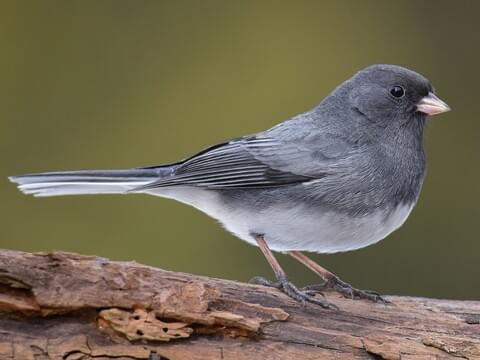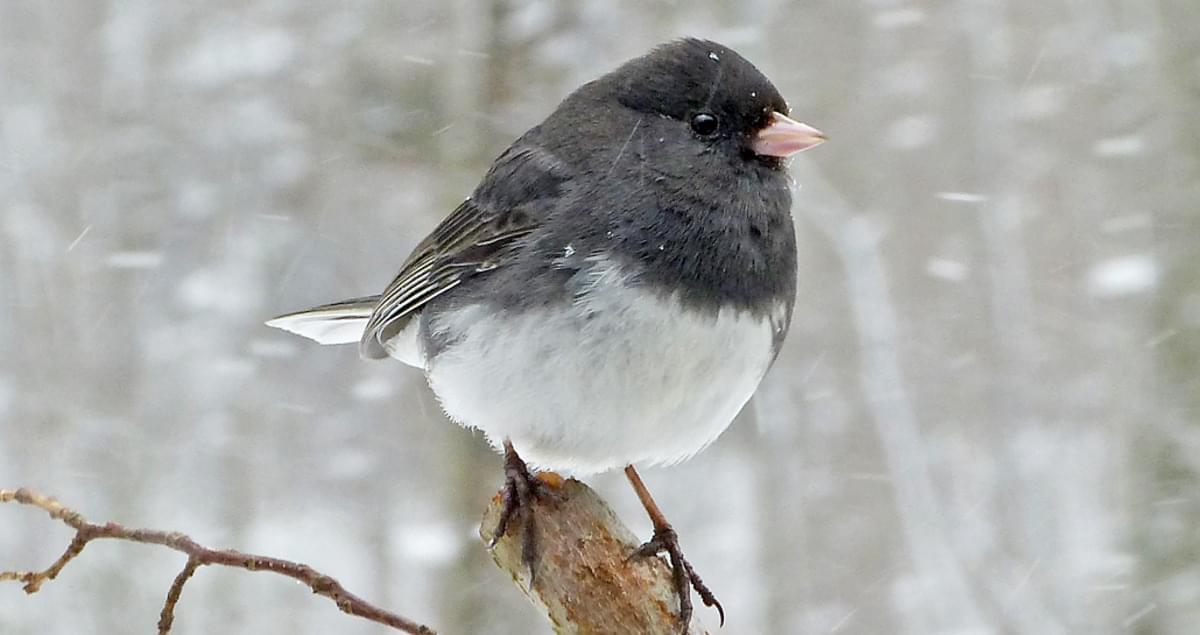Dark-eyed Juncos are a familiar sight during the winter months across the United States. These hardy birds come in various subspecies, each with its own distinct coloration. They can be found breeding and nesting in different regions of North America, from sea level to high elevations. To forage for food, they require bare ground and prefer areas with ground cover. If you’re interested in attracting these charming birds to your yard, planting certain trees and bushes can do the trick. During winter, they embark on a migration journey across the country, although they tend to avoid certain southern regions. Dark-eyed Juncos primarily feed on weed seeds and insects they find on the ground, and sometimes compete with other sparrows for food. By planting evergreen bushes and trees and offering bird feeders, you can create an inviting haven for these delightful winter visitors in your own backyard.

Habitat and Distribution
Habitat
Dark-eyed Juncos can be found in a variety of habitats throughout their range. From sea level to high elevations, these birds are adaptable and can be seen in various environments. They are commonly found in areas with ground cover, such as forests, woodlands, and shrublands. They prefer habitats that provide them with access to bare ground, as they forage on the ground for food.
Distribution
Dark-eyed Juncos have a widespread distribution across North America. They can be found throughout the continental United States and Canada, as well as in parts of Mexico. Their breeding range extends from Alaska and northern Canada down to the southern United States. During the winter months, these birds migrate to different regions, excluding certain southern areas where they are less common.
Physical Characteristics
Colorations
Dark-eyed Juncos exhibit a wide range of color variations among their many subspecies. The most common color variation is the “slate-colored” junco, which has a dark gray head, neck, and upperparts, and a white belly. Other subspecies can have varying degrees of brown, pink, and even yellow hues in their plumage. The “Oregon” junco, for example, has a dark gray hood, chestnut-colored sides, and a white belly.
Subspecies
Dark-eyed Juncos have several distinct subspecies, each with its own unique coloration and distribution range. Some of the most well-known subspecies include the “Oregon” junco, the “Gray-headed” junco, and the “Pink-sided” junco. These subspecies can be found in different parts of North America and exhibit unique variations in plumage.
Breeding and Nesting
Breeding Locations
Dark-eyed Juncos breed in a wide range of habitats, from deep forests to alpine meadows. They can be found nesting in coniferous forests, deciduous forests, and even shrublands. Their breeding range spans from the northern parts of North America down to the southern United States. These birds are highly adaptable and can successfully breed in various environments.
Nesting Habits
Dark-eyed Juncos build cup-shaped nests on or near the ground. They prefer to nest in areas with ample ground cover, such as dense shrubs or clumps of grass. The female constructs the nest using twigs, grass, and moss, and lines it with softer materials like feathers and fine plant fibers. The female typically lays between 3 to 5 eggs, which she incubates for about two weeks. Both parents take turns incubating the eggs and caring for the hatchlings.
Foraging Behavior
Food Sources
Dark-eyed Juncos primarily feed on weed seeds and insects they find on the ground. They have a diet that includes a wide variety of seeds, including those from grasses, weeds, and trees. During the breeding season, they also consume a significant amount of insects. These birds have a unique foraging behavior where they hop on the ground, searching for food in the leaf litter and among grasses.
Competition with Other Sparrows
Dark-eyed Juncos may compete with other sparrows for food, especially in areas where there is limited availability of resources. They have been observed feeding alongside other sparrow species in mixed flocks. However, their ability to forage on the ground and adapt to various habitats allows them to find different sources of food, reducing direct competition with other sparrows.

Migration Patterns
Winter Migration
Dark-eyed Juncos are known for their winter migration across the United States. During the colder months, these birds leave their breeding grounds and travel to more southern regions in search of milder climates and food resources. They can be found wintering in various states, including but not limited to California, Texas, Florida, and the southeastern coast. This winter migration allows them to survive the harsh conditions in their northern breeding range.
Excluded Southern Regions
While Dark-eyed Juncos migrate to many southern regions during the winter, there are certain areas where they are less common or even absent. These excluded southern regions include parts of the Gulf Coast, the Deep South, and areas of southern Texas. The reasons for their absence in these regions may be due to a lack of suitable habitats or competition with other bird species.
Attracting Dark-eyed Juncos to Your Yard
Planting Trees and Bushes
To attract Dark-eyed Juncos to your yard, consider planting trees and bushes that provide suitable habitat for them. Evergreen trees and shrubs can provide year-round cover, while deciduous trees can offer food sources and nesting sites. Additionally, planting native plants can help attract insects, which are an important food source for Dark-eyed Juncos during the breeding season.
Providing Bird Feeders
Another effective way to attract Dark-eyed Juncos to your yard is by providing bird feeders. Fill the feeders with a variety of seeds, such as millet, sunflower seeds, and cracked corn. Placing the feeders on or near the ground will mimic their natural foraging behavior. Make sure to keep the feeders clean and well-stocked throughout the year to encourage their return.
![]()
Importance to Ecosystem
Seed Dispersal
Dark-eyed Juncos play an important role in ecosystem health through seed dispersal. As they forage on the ground and consume a variety of seeds, they inadvertently distribute these seeds to other areas through their droppings. This helps promote plant diversity and allows for the colonization of new areas by different plant species.
Insect Control
During the breeding season, Dark-eyed Juncos feed on insects, playing a role in insect control. They consume a significant amount of insects, including beetles, grasshoppers, and spiders. By reducing insect populations, Dark-eyed Juncos contribute to the balance of ecosystems and help control potential pest outbreaks.
Threats and Conservation
Habitat Loss
One of the major threats to Dark-eyed Juncos is habitat loss. As human development expands and habitat is converted for agriculture and urbanization, the suitable breeding and wintering grounds for these birds become fragmented and diminished. This loss of habitat can lead to population declines and reduced breeding success.
Climate Change Impact
Climate change poses a significant threat to Dark-eyed Juncos and many other bird species. The changing climate can alter the availability of food and suitable breeding habitats. Extreme weather events, such as droughts and storms, can also impact their survival and reproduction. It is crucial to address climate change and take measures to mitigate its effects to protect Dark-eyed Juncos and their habitats.

Research and Studies
Behavioral Studies
Researchers have conducted various studies to better understand the behavior of Dark-eyed Juncos. These studies have focused on their foraging behavior, mating strategies, and vocalizations. By studying these aspects of their behavior, scientists can gain valuable insights into their ecology and contribute to effective conservation efforts.
Population Studies
Population studies are essential for monitoring the population trends and distribution of Dark-eyed Juncos. Researchers track their numbers throughout different regions during breeding and wintering seasons to assess population trends and identify areas of conservation concern. These studies help inform conservation actions and ensure the long-term survival of these birds.
Fun Facts
Snowbird Nickname
Dark-eyed Juncos are often referred to as “snowbirds” due to their presence in many regions during the winter months. As their breeding grounds become covered in snow and temperatures drop, these birds migrate to areas where the climate is milder. Their arrival is often seen as a sign that winter has arrived.
Highly Vocal
Dark-eyed Juncos are known for their lively and varied vocalizations. They have a wide repertoire of songs and calls, including trills, chirps, and musical phrases. Their songs can be heard throughout their breeding range and are often used for communication and territorial defense. Their musical sounds add to the vibrant chorus of bird songs in North American habitats.

Leave a Reply